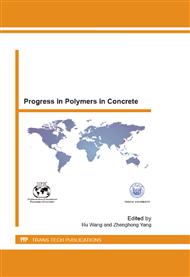[1]
S. Chandra, Y. Ohama, Polymers in Concrete, CRC Press, London, 1994.
Google Scholar
[2]
V. Lefebure, Improvements in or relating to concrete cements, plasters and like, British patent 217.279. (1924)
Google Scholar
[3]
The Concrete Society, Proceedings of the First International Congress on Polymer Concretes 'Polymers in Concrete', The Construction Press, Lancaster UK, 1975.
Google Scholar
[4]
H. R. Sasse, Water-soluble plastics as concrete admixtures, in: Proceedings of First International Congress on Polymer Concretes. The Construction Press, (1975) 168-173.
Google Scholar
[5]
RILEM TC 105 C-PC Concrete-Polymer Composites. The State-of-the Art Report. Eds R. Bareš and L. Czarnecki, 1990.
Google Scholar
[6]
Y. Ohama, Principle of latex modification and some typical properties of latex modified mortars and concretes. ACI Materials Journal, (1987) 511-518.
DOI: 10.14359/2463
Google Scholar
[7]
J. Bijen, Z. Su, Polymer cement concrete: a contribution to modeling of the microstructure, in: Proceedings of TC 113, Symposium on properties and test methods for concrete-polymer composites. Oostende. Ed. Van Gemert D., (1995) 19-27.
Google Scholar
[8]
M. Puterman, W. Malorny, Some doubts and ideas on the microstructure formation of PCC, in: Proceedings of the 9th ICPIC Congress, Bologna,ed. Sandrolini F., 1998, pp.165-178.
Google Scholar
[9]
H. Schorn, M. Schiekel, Shape and distribution of polymer particles in PCC, investigated by ESEM, in: Proceedings of 10th ICPIC, Hawaii, Ed. Fowler D., CD-Rom, 2001.
Google Scholar
[10]
A. Beeldens, D. Van Gemert, H. Schorn, Y. Ohama, L. Czarnecki, L. (2005) From microstructure to macrostructure: an integrated model of structure formation in polymer modified concrete. Materials and Structures. 38 (2005) 601-607.
DOI: 10.1007/bf02481591
Google Scholar
[11]
A. Dimmig-Osburg, Microstructure of PCC – Effects of polymer components and additives. In: Proceedings of 12th ICPIC, Chuncheon, Korea, (2007) 239-248.
Google Scholar
[12]
Y. Tian, Z. Li, H. Ma, N. Jin, An investigation on the microstructure formation of polymer modified mortars in the presence of polyacrylate latex, in: Proceedings of International RILEM Conference on Advances in Construction Materials Through Science and Engineering, Eds. Leung C. and Wan K., Hong Kong, (2011) 71-77.
Google Scholar
[13]
A. Beeldens, Influence of polymer modification on the behaviour of concrete under severe conditions. PhD thesis KU Leuven, 2002.
Google Scholar
[14]
A. Beeldens, D. Van Gemert, Paste-Aggregate Adhesion in Polymer-Cement Porous Concrete, in: Proceedings 2nd International RILEM Symposium ISAP'99, Dresden, Ed. by Y. Ohama and M. Puterman, vol PRO9, 1999, pp.93-102.
Google Scholar


